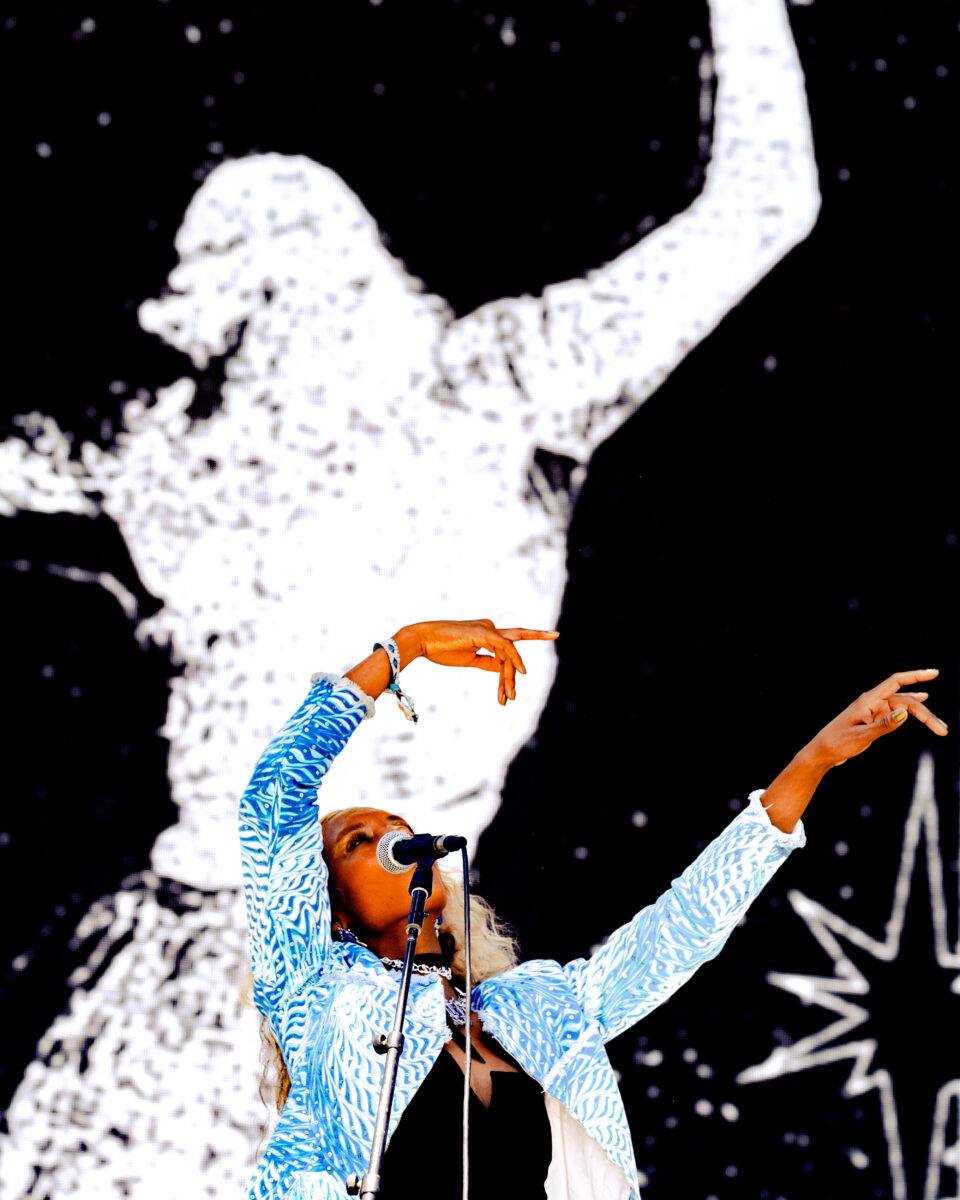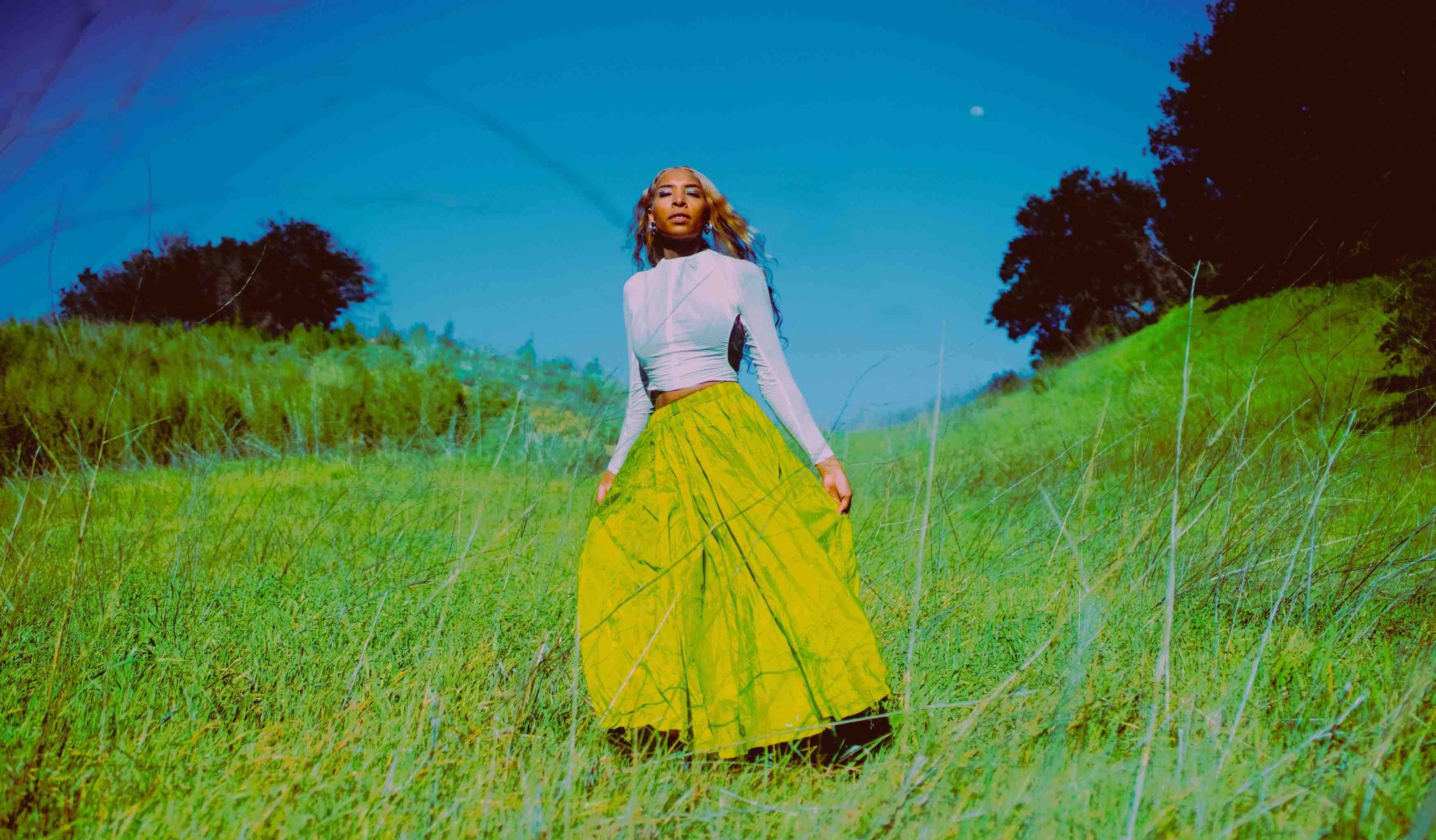The songs on SPELLLING’s new album, SPELLING & the Mystery School aren’t, in fact, new. They make up songs from across her first three records—2017’s Pantheon of Me, 2019’s Mazy Fly, and 2021’s The Turning Wheel—that are creatively reimagined in new and thrilling ways.
The album functions in a similar way to a good film soundtrack: You can either come to the project looking for the ways in which this new project amplifies the original work, or you can approach the re-recordings as their own entities, entire universes unto themselves completely untethered from their origins. That SPELLLING can execute this tightrope walk so seamlessly speaks to her assuredness as a songwriter and composer.
Across Mystery School’s 11 tracks, SPELLLING honors the strength of her original work while invigorating it with entirely new styles and sounds. To add some context to the creative tour de force that is SPELLLING & the Mystery School, we asked the artist born Chrystia Cabral to explain the origins of these songs, as well as how they were adapted to their new forms.
1. “Walk Up to Your House”
Back in 2018, me and some artist friends were invited to create our own soundtrack for Maya Daren films screening at the Berkeley Art Museum. I chose the film Meshes of the Afternoon. The film depicts this surrealist psychic dreamspace where a woman enters and re-enters her home while being pursued by a mysterious hooded figure with a mirrored face.
For some reason while watching I immediately thought of the Three 6 Mafia song “Walk Up to Your House” and how eerie it would be if that song were the soundtrack. For the live score screening I played that lead Three 6 Mafia piano/bell line as a recurring motif. Later I felt inspired to keep working on the track, keeping the Three 6 Mafia song title and eerie vibe, but making a totally new composition. For the Mystery School reimagined version I got to bring in real strings and played around more with sampling to kind of pay homage to its original cinematic inspiration.
2. “Cherry”
“Cherry” is a really elusive song, even to me. It’s definitely tapping into this idea of being in touch with your primal nature and desires, understanding and knowing your anima—the passions that drive you, and having a sort of flirtatious and fun joyride with that part of yourself. This was my favorite one to recreate on Mystery School because I think we did a great job of keeping its really minimal punk core, but adding in so much with the percussion.
3. “They Start the Dance”
Writing the lyrics for “They Start the Dance” was a really special moment where I felt like I’d just picked up on a radio frequency. There was no foreground or concept beforehand—the lyrics “All my children, gather like clouds” had arrived kind of out of thin air, and I built the melodies around that. That almost never happens that way. I wanted the song to sound like it was slowly engulfing and forming as an entity. The song explores this idea of the “unified field,” both in the physics sense and in an artistic sense. I was imagining the music as activating and seducing people into a fountainhead of pure abstract being and bliss through the ritual of music and dance.
4. “Under the Sun”
When I’m in the songwriting process, I often treat my whole life like a treasure hunt. When I’m really fixated on uncovering the mysterious links between lyrics and melodies, I’m constantly seeking out clues around me, especially in my dreams. I had a dream about this really specific store in Sacramento, my hometown. It’s a light store that sells all kinds of light fixtures, chandeliers, lamps, etc. In the dream I went inside and ended up being sucked into this lamp in a very David Lynch fashion, and inside there was this sort of angel genie being I was communicating with.
I woke up that morning and decided to go to Sacramento and try to go inside that store, but it was closed so I went around the corner instead to Time Tested Books. Inside the glass counter I saw Wild Angels by Ursula K Le Guin. It was gorgeous-looking with angels on the cover, and the person working told me Ursula K Le Guin had just passed away the day before. This was my first introduction to an author that would become one of my all-time favorite sci-fi authors. I read it all that afternoon, and that evening got the inspiration for the lyric “Sunlight on the planet dawn” directly from one of the poems in it.
5. “Haunted Water”
Working on the reimagined version of this track was particularly fun and challenging because it’s such an electronic-based song on the Mazy Fly version. I wanted to be able to give it a little bit more of an organic/acoustic tone to be able to sit alongside the other Mystery School tracks and feel cohesive. It’s a song that’s already lived so many lives because it was one of the first songs I used to perform before even having the project name SPELLLING. It was just me looping bass guitar with a fuzz pedal, and it sounded super doom-metal-y. I love this iteration a lot, and it was super fun to revisit some of my darker, gothy SPELLLING roots.
6. “Always”
Most of the songs I write have double meaning—superficially they may seem to be about a certain subject, but they usually have a deeper, more intimate and metaphysical musing underneath. This is one of the few instances where I just straight-up wrote a pure love song from the heart in a very plain and candid way. “Always” is about the insecurities of intimacy, trust, and being brave with your love. The Mystery School version, I think, strips things down even more from the Turning Wheel version to reveal this very raw and bare presentation that matches how it was originally written on the piano.
7. “Sweet Talk”
This song definitely reflects how I romanticize everything around me (kind of how I was describing before about treating the creative process like this treasure hunt). The sun glinting on a spiderweb to reveal delicate but strong matrices and connections that weave life together. Playing this one live toward the end of the set is always really satisfying and a great note I love to leave the audience with.
8. “Boys at School”
I was a little concerned about attempting to do another version of “Boys at School,” because it’s such a titanic song. But it’s my favorite song to perform live—and probably the audience’s as well—so we went for it, because I knew fans would love it and appreciate it. I think we managed to make it even longer than the seven-minute original version. And melodramatic.

Spellling
9. “Hard to Please Reprise”
On Mazy Fly I have a song called “Hard to Please,” and I wanted to revisit the same sentiments from that song in another way, so I made “Hard to Please Reprise.” I think it’s pretty funny that it sounds completely different. “Reprise” is also a sort of interpellation of the song “I Love to Love,” sung by Björk as a very young child that I absolutely adore. In the Björk song, the line is “I love to love, but my baby loves to dance,” and I changed it to “I love to love but my baby loves to fly.” The song is dealing with this sort of romantic desperation to remain safely in a place that exists in the past, and refusing to see or accept that someone you love has changed and moved on—and so have you.
10. “Phantom Farewell”
This is a track originally from the album Pantheon of Me which explores the intricacies of the inner mind and dimensions of self. This track was sort of addressing my depression and anxiety that I struggled with and continue to struggle with today. I’m having a conversation with them, anthropomorphizing them as “phantoms,” creating illusions and distortions to my inner peace. The end groove with the guitar is supposed to feel like this shattering of those illusions, pushing through and finding some form of relief and sense of empowerment even while navigating these challenging states.
11. “Revolution”
I’ve spoken before about this track being about the struggle to feel whole and to find some kind of nirvanic place of “completion” all the while fighting against and living day-to-day within a matrix of exploitation, a world built on the suffering of others. I sing about falling complicit to the grim false narrative of “growing up” becoming someone that has no choice but to live to labor—but that there’s always still a spark of passion to resist this.
I think the “permanent revolution” I sing about is this idea that the yearning will never die, it will only grow more powerful within everyone, and that it’s yearning for a world where our talents and our gifts and virtues are encouraged and nourished and cultivated. This song always gets people dancing in the crowd with the end groove that I kind of fashioned out of inspiration from David Bowie’s song “I’m Deranged” from the Lost Highway soundtrack. I wanted it to sound like that highway scene at the opening and closing credits, like this infinite odyssey into unknown territories, but in an optimistic sense.







